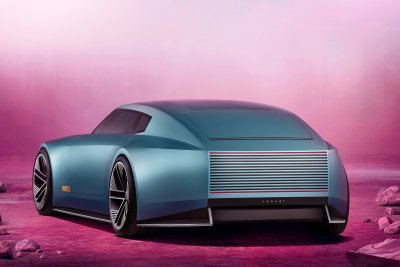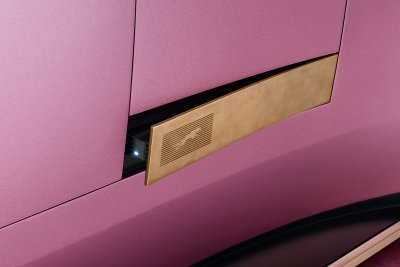Jaguar's new era is here. The British automaker's first design concept premiered during Miami Art Week today. This new vehicle, the Type 00, is an exaggerated two-door grand tourer (GT) that nods toward the company's future four-door GT, which is slated to arrive in 2026.
The concept uses all of the company's new, controversial design touchpoints including the new design mark, logo and strikethrough graphic with the leaping cat.
Jaguar is owned by Indian company Tata. Along with the Defender, Discovery and Range Rover brands, it is the fourth prong of the larger JLR brand strategy, set to sell only super luxury electric vehicles. It's a complete reimagination of the brand from road to roof.
"Miami will be a big signal, in terms of understanding the audiences that were trying to attract. The association with art is a really important one, it's not something that we're layering over the top," Richard Stevens, Jaguar Land Rover design director told Newsweek.



"[JLR's Chief Creative Officer] Gerry (McGovern) is inspired and gets emotional about art; he doesn't collect cars. The emotional connection, the ability to make people feel something, through art, is what we want to associate with. So, Miami will be a big signal of that. That's the kind of link we want to make," he said.
At a preview event in Gaydon, England that Newsweek attended, Stevens said the new JLR will feature a distinct value for each brand and that Jaguar in particular will pursue "fearless creativity" in its new design aesthetic, which looks like nothing that came before from the brand.
Type 00 features the new face of the brand, complete with strikethrough bars and leaping cat. Jaguar uses the phrase "modern exuberance" to describe its new design, which extends to the matte pink surface color.
It has an accentuated long hood and short rear deck, like many Jaguars of the past.
New for the era is the brass ingot on the front quarter panel. In the concept it holds the different totems buyers can use to customize the look and feel of the interior.



There are two spaces in the cabin to place the totems them. Some change the lighting color and ambient sounds in the vehicle while others change the fragrance misted throughout the cabin. Jaguar says it wants drivers to slow down, take a moment and ritualize the drive.
The automatic butterfly doors eventize the vehicle's greeting, "celebrating moments of theater," the company said. The way the totem holder opens from the quarter panel is also part of that, as is the way everything changes in unison when the totems are placed in the center console. Some of the totems are metal and one was travertine, but they all have a heft when held in the hand.
In Miami, Jaguar partnered with new artists in areas from motion art to film and photography and they have been part of the development process, giving an external perspective. Other than the research that they typically do for automotive, the company says it brought people with a "real sense of what's next."



"It's been more insightful, they as a group are influencing the cultural gulf stream that will shift us into a new area, and into this new luxury space. It's probably been one of the most valuable parts of the process," Stevens told Newsweek.
"What you're seeing today is a manifestation of the brand through into the product vision because we're doing that in parallel while also creating and translating that into production. We've created this vision, but at the same time we're also delivering working automobiles," Stevens said when asked about a brand being design forward.
Jaguar said it won't be talking about heritage as much as it previously did, as the well-heeled customers it'll be courting don't care. The company expects prices will double, generally, and the vehicles will get back to the more exclusive air they had in the 1960s.
"We're trying to carve our own path and it's not inspired by any other OEM. One thing I would say is that we're in a really fortunate position because our names, Jaguar included, have resonance outside automotive who are interested in working with us. To help our understanding of luxury in cars, and vice versa. We need to leverage that much more, because that emotional connection isn't just about the end customer. Not all automotive brands have that," Stevens said.






.png)













 English (US) ·
English (US) ·